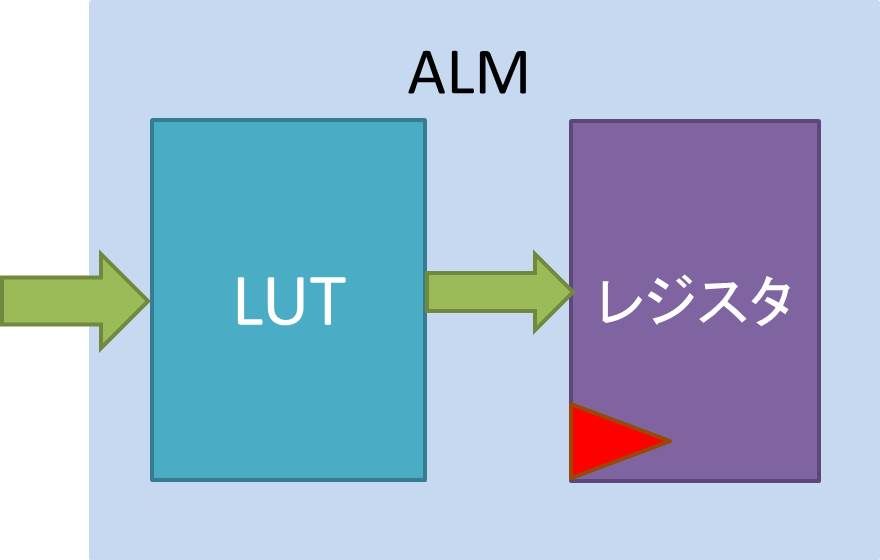はじめに
こんにちは。最近少しずつですが成長を感じてきたなみぃです。
今回は最新デバイスである Stratix® 10 FPGA の 新機能の紹介です。
Stratix 10 にはデザイン全体のパフォーマンスを向上できる注目の新機能がたくさんあります!
今回から数回にわたって紹介予定ですので、皆さんぜひチェックしてください。
Hyper-xx との出会い
=ある日の会議にて=
課長「Stratix 10 のHyperFlexTM に関して……。Hyper-Register が追加されたことにより Hyper-Retiming が……。」
私「(……Hyper ? ) 」
課長「Hyper-Pipelining が………。」
私「…………………」
課長「Hyper-Optimization が…………。」
私「(Hyper- 何とかは一体いくつあるんだ…) 」
Hyper-xx 多いですね…。
そうして、それぞれの区別が付かないまま会議が終了してしまいました。
これはまずいと思い、席に戻って早速調べてみました。
ちなみに、私が認識している Hyper-xx は
・HyperFlex
・Hyper-Register
・Hyper-Retiming
・Hyper-Pipelining
・Hyper-Optimization
の 5 種類。それぞれ何を表すのか見ていきましょう。
HyperFlex とは?
HyperFlex とは FPGA のパフォーマンスを向上させるための仕組み全体のことです。
これは Stratix 10 から追加された仕組みです。
そして実際にパフォーマンスを上げる機能が上記の
・Hyper-Retiming
・Hyper-Pipelining
・Hyper-Optimization
などです。
なぜこれらの新機能が Stratix 10 から使用できるようになったのでしょうか?
そう。それは、新しく追加されたレジスタのおかげです!
それが Hyper-Register です!
Hyper-Register とは?
Hyper-Register とは Stratix 10 から追加された新しいレジスタです。
1入力1出力のシンプルなレジスタで、基本的な機能は ALM レジスタと変わりません。
Stratix 10 内には、この Hyper-Register が多数配置されています。(その数は ALM レジスタの十倍以上!)
そして注目すべきは Hyper-Register の配置位置。
ここが上記の新機能を果たせるようになったポイントなのです。
Hyper-Register の配置箇所
さて、Hyper-Register はどこにあるのでしょうか?
このレジスタは ALM 同士を繋げる配線上に配置されております。
正確に言うと
・配線マトリックス (Row/Column) 交点
・すべてのブロックの入力
に配置されています。
では、従来の FPGA の内部と比較して見てみましょう。


このようにして内部に配置されております。
ALM とは?
補足として、ALM について少し説明します。
ALM は FPGA のロジック最小単位の一つで あり、以下で構成されています。
・LUT (ルックアップテーブル)
・加算器
・レジスタ
FPGA は ALM を組み合わせて、ユーザが記述した回路を実装しています。

Stratix 10 は ALM 内のレジスタと Hyper-Register 両方を持っています。
まとめ
Stratix 10 では Hyper-Register が柔軟に働き
・Hyper-Retiming
・Hyper-Pipelining
・Hyper-Optimization
などの新機能を実現し、パフォーマンス向上をさせることができます!
・HyperFlex
Stratix 10 から導入された FPGA のパフォーマンスを上げる仕組み全体のこと
・Hyper-Retiming、Hyper-Pipelining、Hyper-Optimization など
実際にパフォーマンスを上げるために働く機能
・Hyper- Register
上記の機能を実現するために Stratix 10 から導入されたレジスタ
今回は Hyper –xxが多く、記事作成中に混乱することが多々ありました…。
しかし皆様に理解していただけるよう、分かりやすい記事を目指して頑張ります!
次回記事では新機能の一つ Hyper-Retiming について紹介予定です!
そこで Hyper- Register が具体的にどのように働いているのかが明らかに!?
要チェックですよ!

